Re-Roofing: Should You Put New Shingles Over Existing Shingles or Tear Off?
Reroofing projects begin with many more questions than homeowners have answers, which is perfectly normal and why VIS Exterior has developed the following information. One of the more frequently asked questions is, “can I put new roofing over existing shingles?” The answer depends on a variety of factors that we’ll cover here.
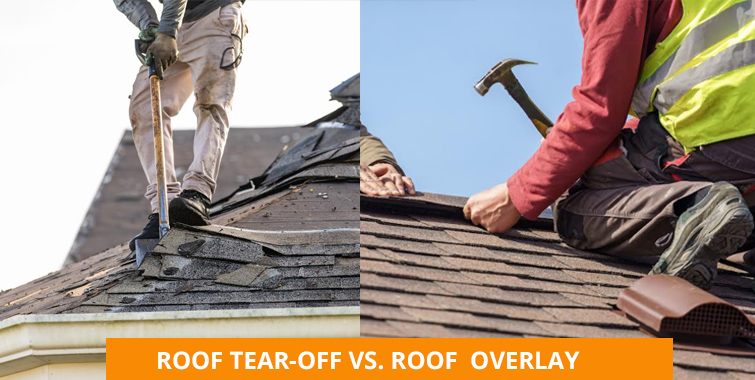
Most homeowners will begin noticing issues with their roofs, signaling that it’s time to begin planning a reroofing project. The first thought is usually to think about the type of material they want to use on the roof, from asphalt shingles to wood cedar. But before a decision needs to be made about material choices, homeowners need to determine if the existing roofing material needs to be torn off or if the new material can go on top of the old.
Does the old roof have a few issues that need to be addressed before the new materials can be installed on top of it, or is it in such bad shape that it needs to come off? For example, there can be extensive issues that might go all the way down to the sublayers, including the plywood (sheathing) that acts as the base layer upon which all the other roofing materials are placed. If this is the case with your roof, shingles cannot be placed atop of the old shingles – rather they will need to be removed before the project can move forward.
The less work that goes into your roofing project, the less it will cost to complete. Therefore, if your old roof needs to come off, count on adding more to the budget.
Table of contents:
- COMMON REROOFING TERMS EXPLAINED

- DIFFERENCE BETWEEN ROOF RECOVERY (OVERLAY) AND ROOF REPLACEMENT (TEAR-OFF)

- WHICH IS BETTER: ROOF OVERLAY VS TEAR OFF ROOFING (PROS & CONS)

- ROOF RECOVERY: WHEN TO PUT NEW SHINGLES OVER OLD SHINGLES

- ROOF REPLACEMENT: WHY TEARING OFF THE OLD ROOF SHINGLES IS A BETTER OPTION

- WHY YOU SHOULDN'T INSTALL A NEW ROOF OVER THE EXISTING SHINGLES?

- SCENARIOS THAT MAKE A TEAR OFF THE SECOND CHOICE

- FINAL VERDICT: ROOFING OVER YOUR EXISTING ROOF IS NOT WORTH IT

- RECOMMENDED ROOFERS FOR FULL ROOF REPLACEMENT IN DUPAGE COUNTY

- FREQUENTLY ASKED QUESTIONS ABOUT RE-ROOFING AND ROOF REPLACEMENT

Common reroofing terms explained
As you plan for your roofing project, it’s important to take a minute and consider some common terminology you’ll need to know:
Reroofing
The process of recovering or replacing an existing roof covering.
Roof recovery
The process of installing an additional roof covering over an existing roof covering.
Roof replacement
The process of removing the existing roof covering, repairing damaged substrate (if required) and installing a new roof.
Difference between roof recovery (overlay) and roof replacement (tear-off)
Are you roofing over an existing roof? In the roofing industry that’s known as a “roof recovery” project. It’s also called an “overlay,” as you’re laying new materials over old materials.
Does your old roof have many, many issues, including substrate problems? You’re going to need a roof replacement, also known as a roof “tear off,” which means you’re tearing off the old one, fixing or replacing problems with the substrate, which is usually .75-in. plywood, and installing brand new roofing materials.
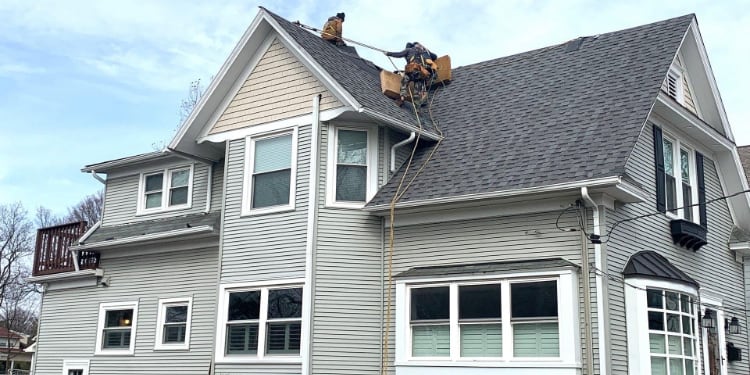
What does it mean to overlay shingles?
Overlay shingles, or roof recovery, refers to the process of installing new shingles on top of old shingles. In this situation the homeowner and contractor have agreed that the old layer of shingles can stay in place. This is often the case on roofs with little to no underlying issues, and without extensive repairs, it’s acceptable to put the new shingles on top of the old ones.
Older homes have likely undergone a handful of roofing projects. The state of Illinois only allows two layers of asphalt shingles on a roof, so if your home has already undergone a roofing project where the contractor has decided to overlay shingles rather than tear them off, you will not be able to do a roof recovery.
What does it mean to “tear-off” a roof?
When a contractor has determined a roof replacement is in order, this means they have decided that the old roofing materials need to be torn off before a new roof can be installed. This is required for a few reasons, one of which is that there are too many problems with the existing roof, such as damaged sublayers that need to be completely replaced. Work like that cannot be completed without tearing off the shingles and other protective layers underneath.
There are also situations where the roof deck is in good working order, but the existing layers of roofing material are damaged to such an extent that installing new shingles on top of them would cause an uneven surface, which puts the roof at risk for water pooling and moisture leakage. While it’s a more time consuming and costly process than a roof overlay, it is a necessity, particularly on roofs where two layers of shingles already exist.
Providing a home with better protection is the goal of any roofing project. Whether it’s for aesthetic reasons or because the current roof is old and damaged, your contractor will make the determination if the roof needs to be replaced or if it is a candidate for overlay.
Which is better: roof overlay vs tear off roofing (pros & cons)
Just about every homeowner will agree that the best roofing project is one that looks great, protects the home and most importantly – is reasonably priced. Whether it’s a roof overlay or if you have to tear off roofing, both projects will result in a better-protected home and one that has more curb appeal. However, when it comes to cost, the roof overlay vs. tear off debate will be in favor of the overlay project.
When the time comes to take on your roofing project, rest assured that your contractor will work in your best interest as well as follow rules and regulations regarding what is legal in the state of Illinois, which is no more than two layers of asphalt shingles. Either way, you can factor the pros and cons in either situation into your budget and work toward getting a new roof that will improve the value of your home.
Pros and cons to consider when deciding to tear off existing shingles vs. overlaying new shingles over the existing ones.
Common advantages of roof overlay and tear off methods:
Budget-friendly
Quick
Easier work
Less refuse/clean up
Greater durability
All-new material
Long-lasting
Guaranteed warranties
Increased property value
There are obvious advantages to either situation, but there will be consequences to both, too. Consult with your roofing contractor and rest assured that the decision you make will be the right one for your home.
Disadvantages of roof overlay and tear off methods:
Trickier maintenance
Improper roof inspections
May present long-term problems
Could affect the resale value
No workmanship warranty
Possibly void of warranties
Less visual appeal
Can't replace underlayment
Adds additional weight
Higher costs
Takes longer
Waste removal needed
Sometimes it’s easier when you don’t have a decision to make, which is the case when your roof already has two layers on it and you will be required to tear off existing materials before the new shingles are installed. However, for those looking to save as much money as possible and the home has only one layer of roofing materials, the pros and cons matter more, as overlaying a roof is more budget friendly.
While the prevailing thought is that a roof with multiple layers of shingles on it is more energy efficient, that’s not always the case, which means there could be a benefit to investing in having old layers removed. For example, some overlay roof projects will conceal problems, which can lead to leaks or heat escaping. The obvious advantage of an overlay project is that you save money, but you also have to consider the long-term costs. Consult with your roofing contractor and rest assured you’re making the right choice.
Roof recovery: when to put new shingles over old shingles
Can you put new shingles over old shingles? The answer is “yes.” putting new shingles over old ones might not be the most common method, but when a contractor deems it a safe and reliable proposition, have confidence that it is the right move in the short term. In the following paragraphs, you’ll find reasons why putting a second layer of shingles on a roof makes sense for specific situations.
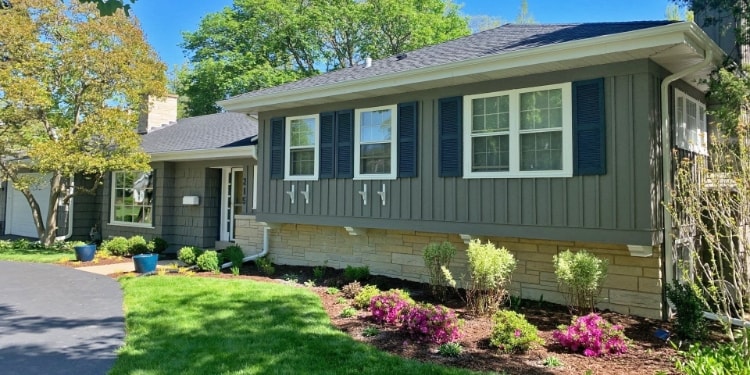
The benefits of roof overlay:
Reduced cost
As with just about any home improvement project, the biggest portion of the budget goes toward labor costs. It’s estimated, on average, that a roof project that does not require tearing off the old roof will cost about 25 percent less than a project that does require that extra labor. But the costs involved include more than just labor – you also have to consider the dumpster rental fees, as well as potential permit fees for renting a dumpster to place on your property or on the street.
Faster completion
While quality contractors do what they can to minimize noise and clutter, roofing projects come with plenty of both. This can be a hassle for some homeowners, which means having the crew on site for as short a time as possible is a big bonus. Rather than having to go through the din of a roof tear off, doing the overlay takes that out of the equation and the time to finish the project is about 25 percent faster.
Easier to manage
Planning the logistics of a roofing project is never easy, but when you take away the multiple steps involved with the tear out phase (dumpster permit, dumpster rental, drop off and pickup), you make the planning that much easier. Putting an extra layer of shingles on a roof rather than removing the existing layer(s) is something you should ask your contractor about.
There’s no doubt that adding another layer of shingles on a roof has benefits, including extra protection from hail damage and potentially adding another thermal layer of protection that can positively impact utility bills. There are times, particularly when the existing roof is still in decent shape and level, when overlay shingles can be considered a short-term benefit.
Roof replacement: why tearing off the old roof shingles is a better option
The reason most roofing projects become roof replacement projects is that it’s usually the best option. Tearing off roof shingles provides numerous advantages that contractors discuss as they discuss your project with you. It’s true that adding the roof tear off steps adds to the overall cost of the project, but it is almost always in your best interest.
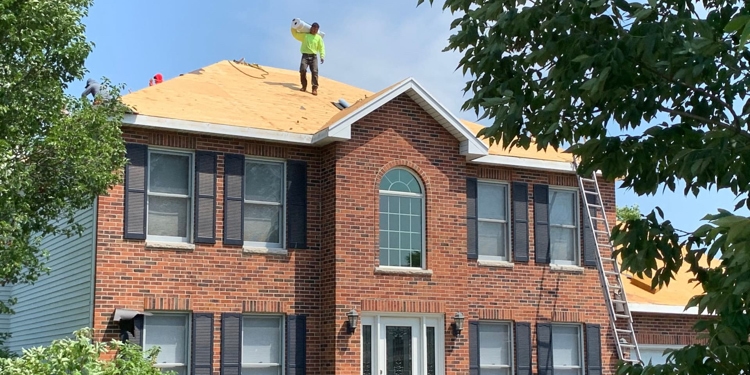
Benefits of a complete roof tear off:
Allows for thorough inspection
The typical roof has multiple layers that are covered by shingles. While the shingles might look a bit aged, the layers underneath could be in horrible shape. One of the only ways to thoroughly inspect a roof is to tear off the existing one. This allows inspectors to see every square foot of sheathing (usually .75-in. plywood) and determine if repairs or replacement is needed.
All-new material
Another reason a contractor might recommend to tear off the existing roof is that everything will be switched out with brand new material, which means you don’t have to worry about the layers beneath the shingles going bad on you anytime soon.
The option to upgrade materials
Roofing materials have improved over time, so if your roof is 20 or 30 years old, there’s a good chance the underlayment, which blocks moisture that gets through the shingles from touching your sheathing, is outdated and can be improved upon. Also, if the previous contractor cut corners and used subpar materials, this is a chance to make a big upgrade to more durable roofing materials.
Respond to climate conditions
Roofing material manufacturers have done plenty of research and design to come up with new products to fight all types of weather. They have also made improvements that can better protect your home against heat and cold. New materials give you a fighting chance against Mother Nature.
Longer lifespan
Asphalt shingles being produced today can have a lifespan of around 30 years. An old existing roof can still degrade, so if you are looking to maximize your new roof’s lifespan, choose the replacement option.
Lower maintenance
When you buy an old car with high mileage, you can expect a high amount of maintenance. It’s the same for old roofs. Rather than worry about what needs to be maintained, completely replace everything and start fresh with a basically maintenance-free roof.
Guaranteed warranties
Most contractors will guarantee their work for five to 10 years, but materials are usually covered for longer periods. However, by the time your roof is 20 years old, the manufacturer’s warranty, which is usually prorated, doesn’t offer much coverage. When you start new, so do your warranties with your contractor and manufacturer.
Increased property value
Curb appeal adds property value, which is important for homeowners who are looking to put their property on the market. But a new roof, which will add two-plus decades of protection to the home, can also bump up the resale value by between $12,000 to $15,000, depending on the size of the home and the type of materials used.
Mold and rot can be difficult to spot, which means if you don’t have the roof torn off, you might miss trouble spots that can lead to disaster later. If you've spotted a leak in one area, there are likely multiple areas that need to be addressed. This is what a full roof tear off can do for you. You can rid yourself of all the worry about underlying problems and start anew.
If you want a watertight roof, have the old one torn off and a new one installed – you’ll have protection for years to come. Add in the curb appeal and the resale value and you’ve got a winning combination of factors that all lead to answering the question of why so many roofing contractors recommend this option.
Why you shouldn't install a new roof over the existing shingles?
Installing new shingles over existing shingles is something contractors will only recommend when the conditions are perfect. A quality contractor will let you know if your roof is a good candidate for this type of project, but it’s not something most of them will end up recommending for a variety of reasons.
The only way to determine if your new roof can be placed atop your existing one is through an inspection that considers every nook and cranny of the roof, including the sheathing. The problem is that with the existing shingles and underlayment intact, it’s difficult to determine exactly what shape the sheathing is in.
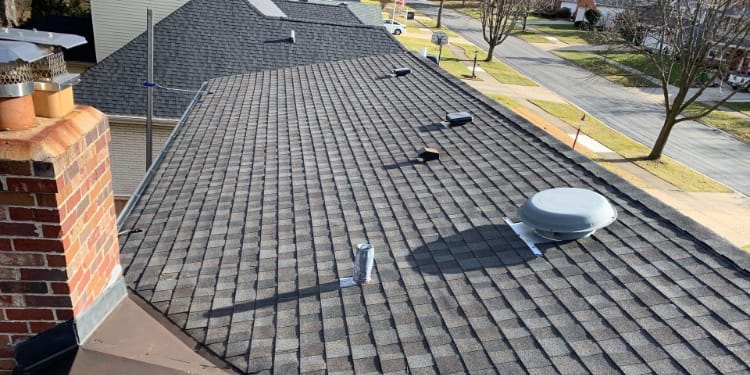
Reasons not to install new shingles on top of old shingles:
While there are some benefits to keeping your old roof intact, there are plenty of reasons why the old one should be torn off. The following are some of the most important:
Roofing materials differ
You can’t put asphalt shingles on top of terracotta tiles – it just doesn’t work. The only way an overlayment works is if you’re using asphalt shingles on top of asphalt shingles. Mixing materials, whether it’s slate or wood, is not recommended.
The roof already has two layers
Building codes in Illinois do not allow more than two layers on roofs. If your house already has two layers, adding another layer simply is not an option. Most homes are not engineered to withstand such weight, which is why a three-layered roof is not legal.
Current shingles are curling or in bad shape
Installing new shingles on old shingles will only work if the old ones are in decent shape. This means they can’t be curling, which is fairly common with old and weathered shingles. If you’re set on preserving the old roof, your contractor will first have to replace trouble spots where curling is visible.
Keep in mind that what’s going on with your old roof will show up on your new roof. For example, any bump or gap on the old roof will imprint on the new one. Furthermore, these imperfections make installation of the new shingles difficult, which can lead to mistakes that result in big problems later.
One way around these imperfections is to use high-quality, thick architectural shingles that can better hide these imperfections, but it’s a premium product and will add on to the cost of the project.
Your roof leaks when it rains
When leaks are spotted in your old roof, there are obvious problems that need to be addressed, and it’s not usually something that can happen without a complete roof replacement. Rarely will the installation of new shingles on old leaky ones fix the problem.
Your roof is soft and spongy feeling
During the inspection process, the contractor will walk across the roof feeling for problem areas. Should they find a soft spot or a “spongy” area, they will know that there is a problem with the sheathing, which will need to be replaced. The best approach is a complete roof replacement.
Less visual appeal
The perk of getting a new roof is that you get that new roof curb appeal. But when you install a new roof over an existing one, you don’t usually get that perk. Rather, the roof might look uneven in areas and lack the consistency of a new roof. Furthermore, shingles are more prone to blow off in these situations, which is why establishing a firm base with new materials is preferred.
Shingles add additional weight
A roof on a 2,000-square-foot home usually spans around 3,000 square feet of surface area. And with the average asphalt roof averaging 425 pounds per 100 square feet, that’s a lot of weight. Now consider having two layers bearing all that weight on the structure. You quickly see how a load like that can put undue stress on a home. Add a snowstorm that dumps a foot or more of snow on your roof and the integrity of the structure is now further compromised.
Most homes in the Chicago area are designed to handle the load of one layer of shingles, as well as the weight of the typical amount of snow for the region. Adding another layer on that is deemed risky by most contractors because it can lead to sagging sheathing and eventually, leaks.
Shorter lifespan of the roof
A variety of existing issues can be detrimental to the lifespan of your new roof when it goes on top of one that is already compromised. For example, if there is any mold or algae growth, it will continue to get worse under the new shingles. Also, did you know a roof with two layers traps more heat than a roof with a single layer of shingles? Finally, even without existing issues, the average overlay roof only lasts for around 16 years.
Can't replace underlayment
Tarpaper, often referred to as underlayment or felt paper, is the layer that goes directly over the top of the sheathing, which is the .75-in. plywood base layer that serves as the roof deck. At some point, water will get under shingles, which is why the underlayment is there – it stops the water from getting into the sheathing. As the roof ages, the underlayment loses its ability to stop moisture from coming through and will eventually fail. Underlayment doesn’t work on top of the old shingles, which means when you do an overlayment, you’re taking a gamble that the old underlayment is going to hold up.
Improper roof inspections
Even though roofing contractors are pros at spotting problems on roofs, they don’t have X-ray vision, so they’re not going to be able to see all the problems hiding under an existing roof. Tearing off the old shingles will give them a thorough look at the roof decking, allowing them a chance to make the small, inexpensive repairs that would otherwise be expensive problems later.
Trickier maintenance
Problem areas are often spotted during routine inspections, which means a quick and easy repair on a roof with one layer of shingles becomes a far more complex problem when the roof has two layers. For example, if the base layer in the attic reveals the beginning of rot, that moisture source could be coming from anywhere, as the water coming through the shingles is diverted multiple times before it finds its way into the base layer.
Most contractors know that taking on a project that involves putting a new roof on an old one is not the most ideal situation, which is why they so often recommend a roof tear off. While the budget will grow a bit with a roof removal phase in the overall plan, it’s often worth the investment.
Scenarios that make a tear off the second choice
Budgets help guide the course of home improvement projects of all types, including roof replacement or overlays. But price is not the only reason a complete tear off becomes the second choice. The following are the most common scenarios that lead to an overlay being the chosen course of action.

The reasons not to choose roof replacement:
Higher costs
Tearing off a roof comes at a cost, which for some homeowners is too hefty a price. A tear off adds to the labor, which is the biggest expense, but there are also dumpster permits and dumpster rental fees that also add to the cost. The average tear off adds roughly 25 percent more to the total cost of the roof project.
Takes longer
When time is of the essence, the complete roof replacement is not an option. Tearing off roof shingles takes time, which will add to the overall timeline of the project. When homeowners encounter time restrictions, the overlay is the way to go.
Excessive waste
Roofing projects are a messy venture, but when you have to tear off all the shingles, underlayment, nails and flashing, that only adds to the mess that must be cleaned up. When given the option, some homeowners will factor in the waste removal in their decision to avoid the tear off.
Contractors will almost always recommend tearing off the old roof because there are so many advantages to that path. However, they will also let you know when an overlay is an option. And while a tear off is more appealing in terms of aesthetics, some homeowners will value time, the lack of waste and saving money.
Final verdict: roofing over your existing roof is not worth it
Roofing over an existing roof is not a desirable option. With new shingles over old shingles, you can potentially run into a variety of problems that you won’t have with a complete tear off. Roof replacement is what just about every reputable roofing contractor recommends, including VIS Exterior, because we recognize that while a roof recovery project is more affordable, it’s not the safest or most durable path for our clients to take.
Experienced roofers know that when the old roof is torn off, problems that were hidden are suddenly in plain view and can be repaired before the new roof is installed. Putting a new roof over an old roof will only hide existing problems, even the small ones that will become expensive issues in the future.
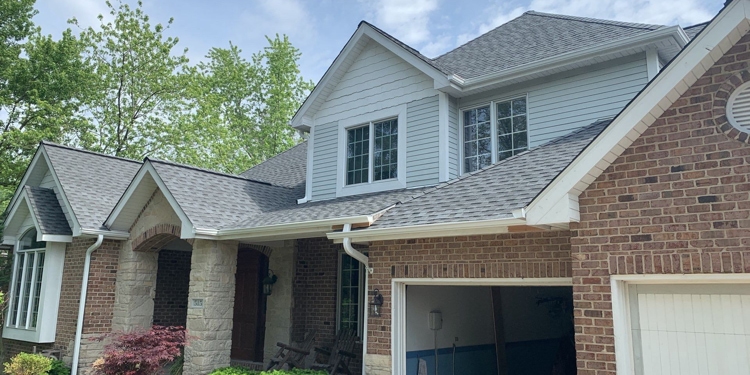
The temporary savings you receive from adding a second layer of shingles does not outweigh the negative aspects:
Consideration of the long-term price
Smart investors plan for the long term rather than trying to achieve short-term gains. Roofs are an investment, too. When considering the short-term gains of installing a new roof over an old one, you get only the immediate advantage of saving money, which is offset by a larger investment in a complete replacement or expensive repairs later, at which point it becomes clear that less money would have been spent if the project would have included paying for the complete tear off from the beginning.
Possible warranties issues
Warranties are important to homeowners. That’s why so many roofing contractors only work with materials that offer a warranty and it’s why contractors offer a warranty on their workmanship. Should you choose to do a recovery project, the warranty on the new shingles could be voided, so it’s important to talk to your contractor about that. The reason warranties are voided in overlays is that shingles aren’t built to be laid atop of the rough granules of other shingles, because doing so will cause abrasions and potential moisture leakage.
Local codes might not allow roof recovery
Most states, including Illinois, do not allow more than two layers on a roof, which means if your roof already has two on it, your only option is to do a complete tear off. Also, check your local building codes to ensure that having more than one layer of roofing is even allowed, because municipalities might have their own take on this issue.
Roof overlay might not look good on an inspection report
Do you plan on putting your house on the market anytime soon? This matters, because before you can sell a home, it has to be inspected and that inspection report will reveal details about your roof. If it has two layers on it, that could be a game changer for the buyer – and not in a good way. The reason is that when it comes time for the new homeowner to take on a roofing project, they will be forced to pay for the complete removal of the existing two layers.
While it might be a stretch to say that roof-recovering projects are a thing of the past, the practice has certainly fallen out of favor with contractors and homeowners alike. Roofing best practices dictate that a roof tear off should precede any roof installation.
Recommended roofers for full roof replacement in DuPage County
Dupage County residents who have partnered with VIS Exterior on a roofing project can tell you we do not recommend doing an overlay, though that is an option we are willing to provide our clients when the conditions for an overlay are right. Our reputation as a customer-centric company proves that we care about the outcomes of our work, which is why we inform homeowners about the risks involved with overlay projects.
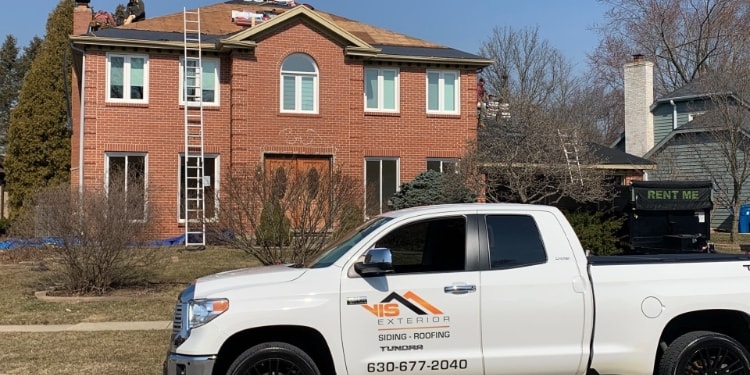
We are the recommended roofers in DuPage County because we are passionate about the services we provide. Our experience informs us on how we approach projects, which means we carefully inspect existing roofs to determine where it is in its lifecycle. If it has lost too much of its function, we cannot responsibly carry out a roof recovering project. Rather, we’ll recommend a tear off so the new roof has a fighting chance of lasting two-plus decades.
Homeowners should feel comfortable about addressing their concerns and discussing their options with their roofing contractor, and that’s what we offer all our clients. You can count on our expertise to guide you to the right decision.
Frequently asked questions about re-roofing and roof replacement
All roofing projects begin with questions. After years of serving local and regional homeowners, VIS Exterior has fielded many, many questions and following are some of the most frequently asked:
What is the difference between re-roofing and roof replacement?
When your existing roof is torn off, that’s referred to as a roof replacement. When new shingles are installed on top of old ones, that’s a re-roofing project.
Can you put shingles over shingles?
Yes, you can put new shingles on top of old ones, but it’s not recommended. Roofs with the most durability, best aesthetics and protection are those that have had the old roof removed first. There is a cost associated with a roof tear off, but it’s worth it in the long term.
Most homeowners are trying to stay within a specific budget, which prompts the question, “can you put shingles over shingles?” Responsible contractors will inform them that yes, it is done from time to time, but it can also cover hidden problems that need to be repaired.
Can you shingle over architectural shingles?
Architectural shingles are thicker and have more detail than 3-tab shingles, so homeowners often ask us, “can you shingle over architectural shingles?” Our answer is, “yes,” but that affirmation comes with a caveat, which is that it’s not recommended. Shingling over existing shingles does not yield the best results for a variety of reasons, one of which is that it could void the warranty on the new shingles, but experience informs us that this method also doesn’t do much to improve the appearance of a home.
Can you put architectural shingles over 3 tab shingles?
Can you put architectural shingles over 3-tab shingles? Yes, but shingling over existing shingles is rarely a good choice. While 3-tab shingles won’t imprint as much as thicker shingles on the newly installed roof, you have to consider that by not tearing off the 3-tab shingles, you could be concealing existing problems that need to be fixed.
The only benefit of an overlay is that it costs you less in the short term. Yet in the long term, an overlay could end up costing you more due to repairs that have to be made down the road. Plus, an overlay lasts about 16 years on average, which means a complete roof replacement will be in order sooner than if you had done a roof tear off.
Can you put a metal roof over shingles?
Can you put a metal roof over shingles? Yes, that is possible, but not recommended. Metal roofs cost up to three times more than shingles, and homeowners who have the budget for a metal roof will also have the budget for a complete tear off of the shingles, and it’s highly advised to take that option. For example, should you overlay with a metal roof, you can’t do a complete inspection of the base layer sheathing. Metal roofs last a long, long time, but if the sheathing fails and needs to be replaced, you will have to tear off perfectly good metal roofing to take on such a project.
You also have to consider that metal roofing panels can only be installed correctly on completely flat surfaces, so if there is any undulation in your old shingles, that will impact the integrity of the installation of the new material. VIS Exterior does not recommend installing metal roofing on top of old shingles.
How long does a second layer of shingles last?
In the best-case-scenario, a second layer of shingles will last 16 years. This longevity only happens when the old roofing materials are in good shape and the sheathing has no flaws. When VIS Exterior clients inquire, “how long does a second layer of shingles last,” our response will include mentioning the risks involved and that the best they can hope for is 16 years, but we will not guarantee they will make it that long before having to take on another roofing project.
How do you tell how many layers of roofing are on your house?
The safest way to see how many layers of shingles are on a roof is to look from the ground. In fact, when shopping for homes, it’s fairly common for prospective homebuyers to glance at the roof to ensure it’s in good shape (nobody wants to take on a roofing project right after buying a home), but they should also be looking to see how many layers are there.
If the roof appears inconsistent, such as raised or lumpy areas of shingles, especially around the vents and flues and any other features, such as skylights, this is a sign that two layers are present. Also, look around the edges of the roof to see if you can spot one or multiple layers. If you have a ladder handy and it’s on safe and level ground, get a closer look at the edges for further validation.
How many layers of roof shingles are allowed in Illinois?
It’s always wise to check with your local governing body to see how many layers of shingles are allowed on a roof. The City of Chicago has mandated that only one layer of roofing can be installed over the original roofing, which means a maximum of two layers is allowed. The only caveat is that a licensed structural engineer can approve of a third layer if he/she deems the structure worthy of supporting that much weight.
Knowing how many layers of shingles you can put on a roof can keep you out of trouble later, but if you’ve hired a respectable roofing contractor, they should be able to tell you that two layers of shingles is probably going to be the most allowable and they will probably even recommend against two.
Are two layers of shingles better than one?
Quality contractors are asked quite often if two layers of shingles is better than one. The prevailing thought is that two layers offer better insulation. The truth is that rarely will two layers offer advantages over a single layer. While a project will go faster and cost less when leaving the original layer of roof intact, there are long-term issues that will cause plenty of unwanted expenses later on.
What circumstances make a roof overlay preferable over a tear off?
Most contractors will tell you that few circumstances exist where a new roof should be installed on an old one, but cost and time are often the only reasons for choosing an overlay. Therefore roofing over old shingles should only be the choice when a quick fix is needed and there are no expectations of long-term gains.
How to put a second layer of shingles on a roof?
While taking on DIY projects around the house can be fun, economical and turn out excellent results, it’s never recommended that non-professionals attempt to roof a home, whether it’s a roof replacement or roof recovery. This is a job for seasoned professionals only, as there are too many things that can go wrong that will only cost you in the end.
When your roof shows signs of needing to be replaced/recovered or if it’s old and you’re certain the time is coming soon, contact a reputable roofing contractor and have them make an assessment of your roof and if it is a good candidate for a second layer of shingles. They will look at specific aspects of your roof to make their decision/recommendation, including how steep the roof is, the integrity of the old roof and the quality of the sheathing.
How to avoid common problems when installing two layers of shingles?
When you install new shingles over old ones, there are some problems that can occur. Before the decision can be made to install a second layer, first and foremost, your contractor needs to check to see if the original roof is in good shape. Was it installed correctly? Are any of the shingles curling or are there any soft spots, sagging or raised areas? Is the roof properly ventilated?
If the determination is made that a second layer can be installed, they need to be level with the first layer and they should be completely perpendicular. You can’t have the top layer crossing over the lower layer or you will see obvious flaws that take away from the aesthetic value of the new shingles.
For residential projects, good contractors know that there are 18 inches between rows of shingles and that the distance on most commercial properties is 24 inches. Going any wider on either type of building will also lead to aesthetic flaws that will take away from the curb value of the property.
What's the average cost to tear off and replace an asphalt shingle roof?
A variety of aspects factor into the cost to tear off and replace a roof. The size of the roof, its steepness, the number of layers that need to be removed, the type of materials being installed and the architectural style of the property, among other things.
To give you a basic idea of the average cost to tear off and replace a roof, let’s use a 2,000 square-foot-roof, which is the average in the U.S. When the existing roof needs to be removed, consider that the average cost is between $300 and $450 per square (roofing terminology for 100-square feet) for asphalt shingles and underlying materials. The total cost, which includes removal and installation, will run between $6,000 and $9,000.
How much does a roof overlay cost?
Those on a budget or under time constraints will lean toward the overlay, because the roof overlay cost is lower and these projects do not take as long as a tear off and installation. On average, an overlay project costs between $250 to $350 per square (100 square feet of roof). So, on that same 2,000-square-foot roof but without tear off, installing shingles will cost between $5,000 and $7,000.












